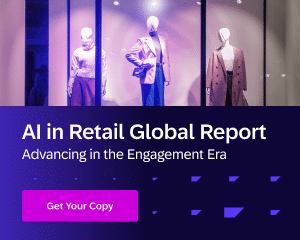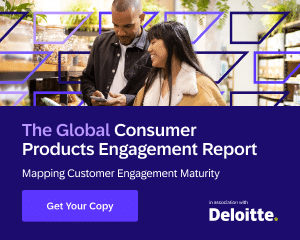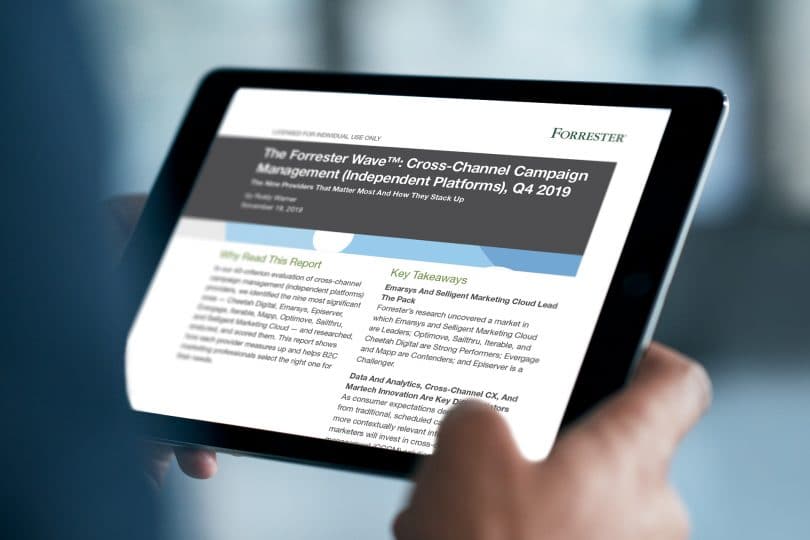“So what?” you may ask.
For us, it is a big deal. First, because we believe it’s a testament that our ideas as well as our ability to execute on them have contributed to our recognition as a leader by Forrester. Naturally there’s pride involved. And second, it is important to our clients to know that the solution they have chosen is among those who are leading the pack and disrupting the way companies think about marketing.
Instead of sales and marketing fluff, or explaining the results which you can check out in the full report, I want to use this opportunity to explain our thought process about where we see the problems in marketing and how we’re developing our solution to solve these challenges.
Channel Vs. Personalization
I wrote Vs. in the heading above because in many solutions there’s confusion about personalization and channels. Often too much emphasis is placed on the channel as the objective, and personalization is an afterthought. This leads to inconsistency in the ability of brands to deliver personalization across all relevant channels.
Why? Because personalization is the BIG idea. The channel itself is merely a means to an end. The ultimate objective is to personalize the experience of the customer. One needs to ask who is the customer, what does she want, at what price, in which channel, at what time, etc. This cannot be achieved in one channel, and the Forrester Wave CCCM Report states that our clients use at least ten channels on average.
AI Beyond the BS
It drives me nuts when I hear so many people using the term AI without a clear understanding of how this technology improves human capabilities — in our case, that means marketers. As with channels, AI is a means to an end, not an end goal itself. We see AI as a technology that analyzes and predicts future behavior and acts on this data to create meaningful interactions between the brand and the consumer.
Example? Sure! You’re a marketer, I am your customer. Take all my data — contact info, preferences, behavior in-store, real time in your app, real time in your web, catalog views and buys, and all my purchases with you. Now engage me. Give me the right product at the right price, at the right time with a specific call to action that works for me. Don’t over do it. Just engage with me at the right moment.
Now multiply this across a customer base of hundreds of thousands. That requires scalability, and that’s exactly how we’re using this technology. Yep, you need tons of data to feed AI algorithms for it to actually provide good outputs, but once you have that, you can apply AI to every method marketers use to engage consumers on a 1:1 basis, predict the future and keep adapting the output based on behavioral change. Food for thought: when someone tells you AI’s this and AI’s that, ask them what does the tech actually do?
The Pieces of the Puzzle Must Fit
Have I established how important data is? Good. (If not, then PM me!) Databases need one source of truth where all data pieces are connected. This is, at best, very hard to do across different solutions, whether you’re piecing them together in-house or you’re buying both the solutions and services from the same vendor. Our built-not-bought approach enabled us to develop a complete loyalty solution and web channel in less than a year while still adhering to the same personalization rules I stated earlier. Simply think about the Apple approach in iPhone vs. Google’s in Android.
Tech Should Work for Humans Rather than the Other Way Around
There’s tons of tech and functionalities that will enable you to do a lot. Really. But you probably know there’s a catch here, and you’re damn right about that! There is a belief that knowledge resides either on the vendor’s side or the marketer’s side, and that there’s enough budget to manually embed all that knowledge into the tech.
The harsh reality is that knowledge is scarce, as are budgets and, especially, time. We believe that every piece of knowledge in marketing that is related to a vertical and operation should be served to the marketer on a silver platter right there in the software. There should be no more focus on the features and functionality of a piece of tech that’s part of a complicated marketing stack. Instead, marketers should seek out a complete solution.
Final Thoughts
I could go on for hours here as we’re very passionate about marketing and changing the status quo, but I think that’s enough for now, enough to give you a good idea about why we’re a leader.
But hey, don’t just take my word for it, take it from Puma:
“At PUMA we pride ourselves on being the fastest and most personal sports brand in everything we do. Emarsys is an incredibly valuable strategic partner in our efforts to deliver more relevant, contextual and personalized marketing communications to our customers,” says Rick Almeida, Vice President, Ecommerce at PUMA. “By leveraging AI and automation against its rich vertical first-party data, Emarsys allows brands like ours to generate greater insights into consumer behaviors, create more consistent, personalized journeys and deliver them across all of our consumers’ different touchpoints, whether online or offline, within one single platform. Our partnership has not only transformed how we communicate with our customers, but also allowed our marketing team to spend more time creating better engagements for consumers wherever and whenever they engage with our brand.”
If you’re a client, thanks for your support, and if you’re a curious marketer, we’d love to discover how we can help you achieve more with us.
Ohad
Handpicked Related Content:
- The Forrester WaveTM: Cross-Channel Campaign Management (Independent Platforms), Q4 2019 Report: Emarsys Named as a Leader
- Making Immediate Impact with AI whitepaper
- Delivering Faster E-commerce Growth whitepaper

FIND OUT WHO’S BEEN NAMED A LEADER IN CROSS-CHANNEL CAMPAIGN MANAGEMENT AND WHY












